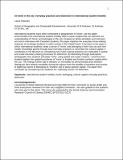Files in this item
At home in the city : everyday practices and distinction in international student mobility
Item metadata
| dc.contributor.author | Prazeres, Laura | |
| dc.date.accessioned | 2018-05-10T23:33:07Z | |
| dc.date.available | 2018-05-10T23:33:07Z | |
| dc.date.issued | 2018 | |
| dc.identifier | 251414557 | |
| dc.identifier | 7b35d51e-a449-40c2-ba4d-c84fdb574ae7 | |
| dc.identifier | 85019090659 | |
| dc.identifier | 000445002800005 | |
| dc.identifier.citation | Prazeres , L 2018 , ' At home in the city : everyday practices and distinction in international student mobility ' , Social and Cultural Geography , vol. 19 , no. 7 , pp. 914-934 . https://doi.org/10.1080/14649365.2017.1323343 | en |
| dc.identifier.issn | 1464-9365 | |
| dc.identifier.uri | https://hdl.handle.net/10023/13329 | |
| dc.description | This work was supported by the Social Sciences and Humanities Research Council of Canada (SSHRC) [#752-2012-0127] | en |
| dc.description.abstract | International students have been overlooked in geographies of ‘home’, yet this paper demonstrates how international student mobility offers unique insights that can advance our understanding of ‘home’ and belonging in the city. Drawing on photo-elicitation and mid-point and return interviews with Canadian students, this paper explores the everyday home-making practices of exchange students in urban centres in the Global South. It focuses on the ways in which international students create a sense of ‘home’ and belonging in their host city and how insider knowledge gained through local everyday practices is converted into cultural capital. It contributes to the literature by considering how home-making practices are implicated in spatial and scalar boundary-making processes for distinction. By illustrating through participants’ photographs how students articulate ‘home’ using spatial and scalar markers, I examine how students tighten the spatial boundaries of ‘home’ to focalise and localise symbolic capital within the city. The findings further add to debates on immobility by demonstrating that students’ distinguish their relative immobility during the sojourn from the mobility of travellers and tourists to legitimise claims of belonging as ‘insiders’ and of place-specific capital. The paper then concludes by considering how students are ‘collecting homes’ for distinction. | |
| dc.format.extent | 257480 | |
| dc.language.iso | eng | |
| dc.relation.ispartof | Social and Cultural Geography | en |
| dc.subject | International student mobility | en |
| dc.subject | Home | en |
| dc.subject | Belonging | en |
| dc.subject | Cultural capital | en |
| dc.subject | Everyday practices | en |
| dc.subject | Distinction | en |
| dc.subject | G Geography (General) | en |
| dc.subject | GF Human ecology. Anthropogeography | en |
| dc.subject | H Social Sciences (General) | en |
| dc.subject | NDAS | en |
| dc.subject.lcc | G1 | en |
| dc.subject.lcc | GF | en |
| dc.subject.lcc | H1 | en |
| dc.title | At home in the city : everyday practices and distinction in international student mobility | en |
| dc.type | Journal article | en |
| dc.contributor.institution | University of St Andrews. School of Geography & Sustainable Development | en |
| dc.contributor.institution | University of St Andrews. School of Geography and Geosciences | en |
| dc.identifier.doi | 10.1080/14649365.2017.1323343 | |
| dc.description.status | Peer reviewed | en |
| dc.date.embargoedUntil | 2018-05-10 |
This item appears in the following Collection(s)
Items in the St Andrews Research Repository are protected by copyright, with all rights reserved, unless otherwise indicated.

